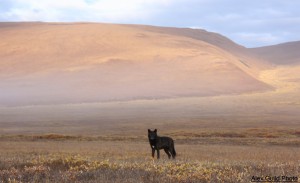By Michael Wald Co-Owner and Guide
Each region in Alaska has a prime season, when traveling conditions, wildlife, and weather all align for the optimal experience. I was recently asked how I would plan the ultimate Alaska summer if my goals were to see wildlife at its peak abundance in the most remote and wild places possible.
Here is my rough itinerary for the perfect Alaska summer.
1) Late April and the first of May in Southeast Alaska for humpbacks, herring, and waterfowl.
2) May 5 -10 in Cordova for shorebirds, and May 10 -15 in Homer for more shorebirds.
3) First 2 weeks of June on the Yukon- Kuskokwim Delta for some of the best birding in the state including Spectacled Eiders and other rarities. While out in southwest Alaska a trip to Round Island to see the walrus is in order too.
4) Second half of June in Arctic Alaska to experience the great herds of caribou migrating across the tundra. June 13-21 is ideal for the Kokolik River near the calving grounds of the Western Arctic Herd. For late June, the Arctic National Wildlife is the best place for seeing the caribou by the thousands, as they cross the coastal plain.
5) Early July is perfect for the Katmai Coast where enormous bears feed in the sedge meadows and scour the beach for food.
6) Late July is a brief window of relative calm in the Aleutian Islands. In addition to the geothermal wonders, the Aleutians have some of the best whale watching and sea-birds in the world.
7) Muskoxen are relatively sedentary year-round but with generally decent weather on the Seward Peninsula in early August, it is a good time to watch the muskox calves frolic while the shaggy cows graze peacefully.
8] Gates of the Arctic National Park is prime in mid-August. The Noatak River is one of the most reliable places to see grizzly bears in the Brooks Range. And I know of no other place where we see wolves with such regularity. Some years, caribou from the Western Arctic Herd also swim the river adding yet more wildlife to this rich experience.
9) At the beginning of September many birds flee Alaska and the last place they stop before heading south is Izembek Lagoon. Waterfowl are the biggest draw, but shorebirds and other migrants also feed here in the fall.
10) Late September and October are early winter on the Arctic Coast and this is when Polar Bears congregate at Barter Island. There is no place in the world with Polar Bear viewing as good as this.
11) And for a grand finale, The Chilkat River near Haines, hosts the world’s largest congregation of Bald Eagles each November.
Whew… What a summer that would be.
I’m sure I’ve missed some great wildlife trips on my list. What are your favorites?



